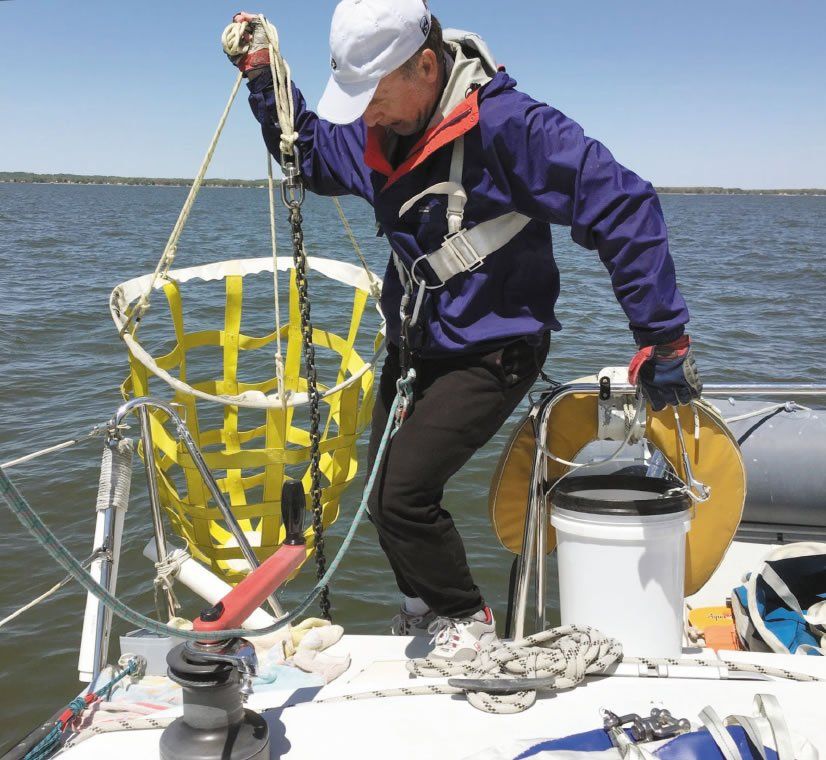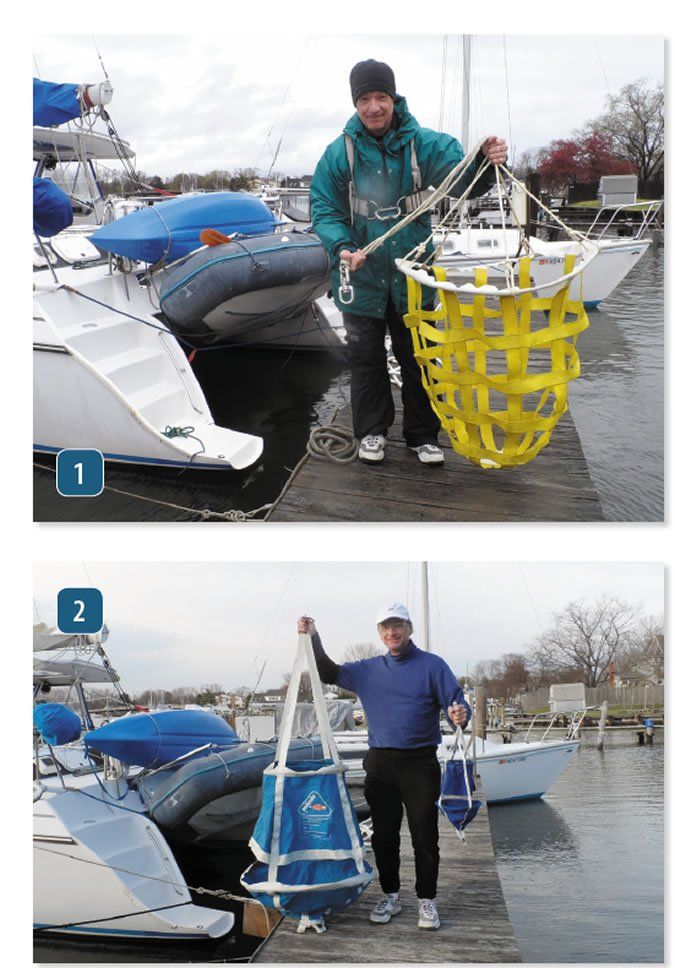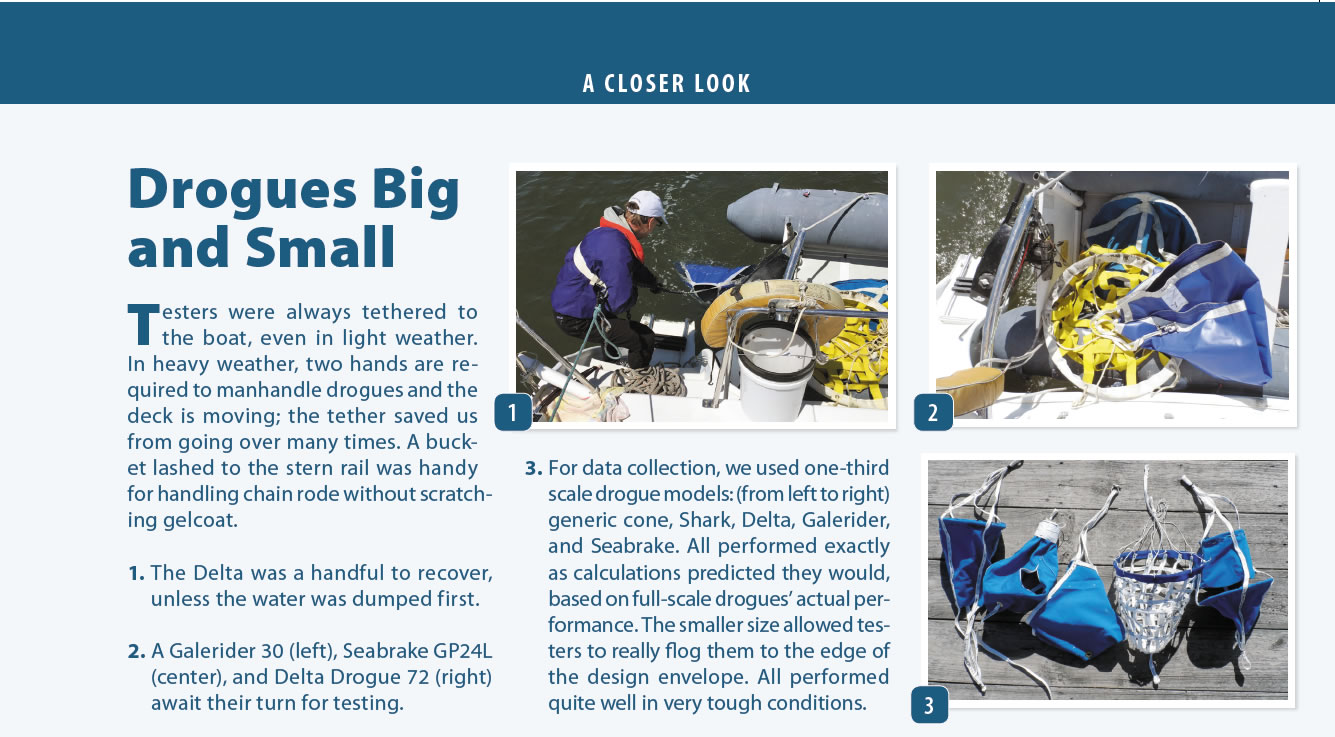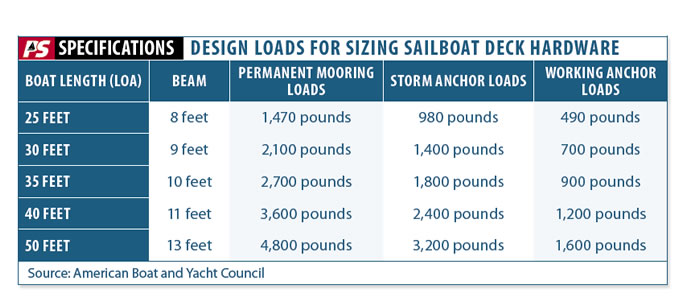Weve long been interested in drogues, devices specifically designed to be towed behind a boat to reduce speed and to produce directional stability in heavy weather. Our last major drogue test was in 2009, when noted marine writers and circumnavigators Evans Starzinger and Beth Leonard shared their storm tactics (see Heavy Weather Sailing Tactics”. Another relevant article, Sea Anchors and Drogues, compared a variety of drag devices. If you are interested in purchasing a drogue, we recommend reading the archive articles along with this report.
This study was intentionally limited to drogues for small to medium size boats (those between 30 and 45 feet). These are the boats that are more likely to benefit from using a drogue. Smaller boats rarely encounter conditions requiring a drogue, and on bigger boats, the high loads associated with using a drogue become problematic.
Weve also limited our discussion to gale conditions (sustained 47 knots with higher gusts). With modern forecasting, very few sailors will ever experience a storm of this intensity underway, and the cautious coastal sailor never should. There are sailing-resource books that address using drogues in more severe conditions, but since our key data was recorded in sustained winds of 35 knots with gusts to 47 knots, the topic was beyond the scope of this report.
Photos by Drew Frye

What We Tested
Our tests focused on drogues, which should not be confused with sea anchors. Drogues are generally deployed from the stern in heavy weather to slow a boat down and to add directional stability to prevent a broach. Sea anchors are typically deployed from the bow and are designed to hold a boat nearly stationary; parachute-type sea anchors from Fiorentino and Para-Tech fall into this category. For more on sea anchors and their use, see Sea Anchor Match-up, in the Feb. 1, 2005 issue online.
Drogues are divided into two classes, with no absolute dividing line. Medium-drag devices are intended to slow the boat significantly and to apply more than 2,000 pounds of restraining force in the event of a very steep or breaking wave. Depending on size, they generally limit vessel steering, allowing only a downwind or slight reaching course. Ace Sailmakers Jordan Series Drogue and the Ocean Safety Para Drogue (depending on vessel it is used with) fall into this category, although other drogues would qualify if they are oversized for the vessel.
Our focus for this test was on low-drag devices intended for steering a boat in difficult downwind sailing conditions, reducing yawing, preventing surfing, reducing broach potential, and generally making the life of the autopilot or helmsman easier. These devices can also be used to provide some steering control for a boat that has a damaged rudder.
Low-drag drogues can be further classified into several design groups, each with features intended to improve stability at greater speeds as compared to standard parachute drogues. The Jimmy Green Yacht Drogue is an elongated cone, providing some glide surface for the water. The Para Drogue is a slotted parachute, with openings intended to stabilize flow along the canopy. The net-like Galerider, made by Hathaway, Reiser & Raymond, is made using heavy-duty webbing. And finally, there are the ballutes-the Burke Marine Seabrake, Fiorentino Shark, and Para-Tech Delta Drogue. A hybrid between balloon and parachute (thus the portmanteau ballutes), they operate like devices used to slow high-speed air and land craft.
We fabricated one-third-scale versions of the major drogue types. This allowed us to roughly confirm scale-up factors and observe drogue behavior at higher loads. Data from small-scale tests was not used in calculating loads that appear in the accompanying table. Except where noted, the table data is based on testing on the following products:
The full-size Seabrake GP24L, Delta Drogue 72, Galerider 30, and Yacht Drogue 25 were tested multiple times in a wide range of sea conditions:
The Ocean Safety Para Drogue was tested in flat water only.
The Jordan Series Drogue (109 cones) was tested once in flat water to confirm drag data.
Not tested: Fiorentino Small Shark and other sizes of all drogues.
We also tested a few do-it-yourself options: a towed warp (half-inch line plus chain) and a towed milk crate.
How We Tested
Although every manufacturer makes recommendations regarding the drogue size for a given vessel, its not always clear under what conditions their guidance is appropriate, and each boat and captain will have different storm management tactics.
Some sailors believe a boat should sail fairly unrestrained, while others believe in more aggressive efforts to reduce speed.
Our test focused on relevant performance and design details that we could objectively compare, including the counteracting forces generated by each drogue, how each drogue behaved in the water, and how easy they were to deploy and recover. We quantified the drag force versus speed for various drogue types and sizes.
To evaluate factors that we could not physically test, such as the effects of wave dynamics (acceleration, angular change, and oscillation), we turned to other studies and databases, creating an extremely comprehensive data set for analysis. Finally, testers examined each drogue for construction quality and strength. For more details on test procedures, see How We Tested on top right.
Observations
Drogue makers recommend slowing the boat to a few knots and slowly feeding out rode, but that might not always be possible. In order to test the construction of the full-size drogues, we set each at 7.5 to 9 knots of boat speed, and none resulted in undue force on cleats. Keep in mind, this is not the recommended procedure. The point is that all of the test drogues were constructed to withstand many times the strain they should actually develop in the water.
Medium Scope
Testers found very few surprises when testing at medium scope (100 feet). This is much shorter than the 350 feet generally recommended for actual use, but for testing, we sought to determine how the drogues would behave in steep, breaking waves. In a storm with dangerous breaking waves, the angle of the rode to the water is greatly reduced by the steepness of a breaking wave face, and the most common failure of a drogue is for it to pull out of steep wave faces.
All of the drogues produced drag forces roughly proportional to the square of the boat speed. When the speed doubles, as long as the drogue stays in the water, drag force quadruples. Steady-speed testing using a sailboat, of course, does not tell us about higher speeds, so we towed one-third-scale models with a tender at up to 10 knots; the behavior of the drogues and the drag versus speed relationship did not differ significantly. The ratio of drag to projected area was also consistent for each basic design. All of the drogues stayed near the surface at higher speeds, but none broke the surface significantly.
In most cases, the amount of drag fluctuated greatly. Readings varied by 35 to 60 percent over a three- to five-second timespan when towed at 5 knots. The dramatic exception was the Galerider, which fluctuated only 10 to 20 percent. The difference is likely explained by a basic design difference; while most designs inflate into solid shapes, the Galerider strains the water through a webbing net. The warp also gave very smooth drag, presumably due to its small cross-section.
All of the drogues rotated to some extent, but this varied with sea state and speed. None spun enough to impair function, even when testers removed the swivels. For systems that include a swivel, its important to use a good-quality swivel and to keep it in good repair.
Testers only noted significant lateral movement with the Jimmy Green drogue. This yawing would likely increase chafe on the rode, where it is led through a chock. Presumably, it could also affect steering, as it was occasionally pronounced, as much as 8 degrees to the side. All other devices in the test tracked straight.
Short Scope
We expected larger differences between models at short scope (50 feet), but there was not a wide variation. The solid drogues (Delta Drogue, Seabrake, and Shark) create a bulge of water as they approach the surface under high load. In order for the drogue to emerge, the force must be sustained for several seconds to disperse this lump of water, and then the drogue will suddenly surface.
The Galerider, on the other hand, functions by straining the water and is less affected by its proximity to the waters surface, smoothly emerging and re-engaging. The Jimmy Green drogue was more prone to skipping when it broke the surface, likely an indicator of how any cone design would behave if it were yanked from a wave face; all others smoothly re-engaged.
Drogue drag is not directly related to model size, so be sure to look at drag data and not just size when selecting a drogue. Additionally, makers are not all on the same page when it comes to storm tactics. Some recommend relatively low drag so that the boat will still be pushed forward (and possibly retain steerage) as it absorbs some of the wave energy, while others believe in higher drag to deliver positive speed reduction. If you prefer a low-drag design (Galerider, for example) but would like more drag, you can consider going up a size.
Some of the devices we tested included an attached weight, such as a mushroom anchor, to prevent the drogues surfacing. Conventional wisdom suggests that 10 to 30 feet of chain (length and weight will depend on drogue type and size) should be placed in front of the drogue to keep it submerged and to sink it nose-first in the lulls, preventing slack from forming in the rode between waves.
Fiorentino, however, recommends adding the weight to the tail of its Shark via a dedicated pendant. Testers noted that attaching the chain to the tail made deployment easier.
While the weight of the chain or mushroom anchor will help keep the drogue in the water, hydrodynamic forces around the drogue and in the waves are far more influential.
Interestingly, Galerider does not address using chain, except on very short rodes when used for emergency steering; however, many users do add a chain leader, which they say improves performance.
When budgeting for a new drogue, remember that the drogue itself is only about half of the total cost. The rode, swivels, chain, and shackles can add $500 to $700. For rode, we prefer double-braid or plait material; three-strand tends to unlay and hockle under high load. Follow the vendors advice on which rode material is best. Most vendors recommend rodes made of nylon, which is relatively elastic (helpful for absorbing shock), but Burke Marine recommends less-stretchy polyester for its Seabrake.
Shark
Of those tested, Fiorentinos Shark was the easiest drogue to deploy, particularly in strong winds. It packed small, used a tail weight (typically a small mushroom anchor) in place of chain, and was the easiest to get into the water. Testers liked the compact and tangle-free construction, which appears to be designed to withstand anything.
We did not field test a production version of the Shark, but our research, along with the data and video footage we reviewed and our extensive testing of a the scaled model suggest it behaves like drogues of similar design.
Bottom line: Durability, stability, and appropriate drag levels earn the Shark a Recommended rating.

Galerider
The popular Galerider design shined in our tests, even as we pushed our speeds and loads higher. Based upon one-third-model testing, there seems to be no practical upper speed limit to its stable performance, and testers noted that it had considerably less tendency to surface at long rode lengths, even with no chain attached. It comes with its own shackle.
This was the only drogue design tested that did not surface at 4 to 5 knots on 100 feet of rode. The drag numbers, whether near the surface or submerged, fluctuated far less than those of the other drogues. The designs many small openings seem to cancel out any oscillation.
The only downside is the relatively low drag for its size, which means many boats will need a very large drogue. The metal mouth of the webbed basket will coil enough to allow for storage, but folding it requires a very firm hand to return it to the bag. Grip the drogue well when unpacking; it springs into shape with considerable force.
Owners of older Galeriders should check the wire ring. There have been a few reports of wire ring failure. Fortunately, this isn’t crippling and is easily repaired, but it does cause increased yawing. Considering the long service history of the unit (more than 1,000 units over 20 years), durability has generally been very good. Recovery was easy, though its large mouth does like to snag rudders and transoms (a boat hook helps).
Bottom line: The Galerider is the Best Choice drogue for steering and storm use.
Jimmy Green Yacht Drogue
A generic-looking cone, the Jimmy Green Marine Yacht Drogue 25 suffers from weaknesses common to this design group; it tends to yaw aggressively at speeds over 3 knots. When pulled from a wave, the occurrence is more sudden and complete than with other designs. We also have some concerns about its durability in a prolonged storm. On the other hand, it is much less expensive than other drogues and seems sturdy enough for some rough use. It also drains rapidly for easy retrieval.
Bottom line: This drogue may be useful for emergency steering in moderate conditions with smaller boats, but is not recommended for sustained storms.
Seabrake GP24L
The Seabrake GP24L, made by Burke Marine, has been in service for years on one of our test boats, a PDQ 32 catamaran. While weve found it useful for preventing a broach in steep breaking waves at inlets, weve not tested it in more severe conditions.
When the bridle is shortened to reduce drag, it becomes a little less stable, though it never tangled or inverted in use. Retrieval ease met expectations for a larger drogue. Water drains quickly for recovery, and the design is snag-free coming on board.
Bottom line: We Recommend the Seabrake for emergency steering on larger boats and for storm use on smaller boats.
Delta Drogue 72
The Delta Drogue was designed by a longtime player in this field, Para-Tech Engineering. Made of fabric and shaped like an equilateral triangle, the 72-inch Delta is dimensionally similar to other units in the test, such as the Seabrake GP24L. At very short scope, the Delta 72 occasionally had the bad habit of skipping out of the water when overloaded, but it always re-engaged before any effect was noticed. It behaved very well at normal scope. Since the drogue holds water, users must dump it during recovery before lifting it onboard. The elegantly simple design, which stows in a tiny bag, is functional, well-proven, and strong.
Bottom line: The Delta 72 earned the Budget Buy pick for a real offshore drogue.
Para Drogue Single
Made in the U.K., Ocean Safetys Para Drogue offered more drag than other speed-limiting drogues; however, we were only able to test this for a few hours in calm conditions.
The Para Drogue seemed quite stable under a steady pull and was not prone to surfacing or yawing. Our impression was that it was more suited to speed limiting use in a strong storm or to assist with emergency steering on a larger yacht. Like all parachute drogues without tripping lines, recovery was cumbersome but not unreasonable.
Bottom line: There is limited information on this device, and we did not spend enough time with it to offer a fair assessment. We would be interested in hearing first-hand reports from anyone who has used it (email [email protected]) and will look for more opportunities to further evaluate it.
Jordan Series Drogue
Although we did not test a production-ready Jordan Series Drogue (JSD), our report in 2000 discussed the JSDs pros and cons, and there is plenty of data regarding its ability to create significant drag.
The result of a U.S. Coast Guard research project led by former Massachusetts Institute of Technology professor Donald Jordan in 1987, the series drogue typically comprises 90 to 200 cones with 5-inch diameters evenly spaced along hundreds of feet of rode, with a weight at the rode end to hold the tail down. The brilliance of the design is that the failure of a single element, whether by mechanical failure or by being pulled out of the water, makes no difference. The pull is steady, whatever the conditions. The downsides are that the construction is bulky, the drogue is notoriously laborious to recover, and during a moderate gale, it will generate enough resistance to hold the boat nearly motionless, as with a sea anchor. For the JSD to perform as a drogue generally requires more wind and wave energy, as one would encounter in a severe storm.
This design was developed for simplicity of construction, and many do-it-yourself series drogues have been built, although several sailmakers (including Ace Sailmakers) supply completed drogues. When compared to other drogues, the JSDs price seems high (see Value Guide), but the rode is included in the fabrication.
Bottom line: When sized appropriately, the JSD drogue is well-engineered for storm survival. Recommended.
DIY Warps
To create a warp, testers used 200 feet of half-inch line plus 30 feet of 3/8-inch chain. The length we tested provided about 10 percent the drag resistance of appropriately sized drogues. If three to five times the length of chain and rope were deployed, the force would become noticeable, but it would still be less than the force generated by a conventional drogue. In tests, warps offered extremely easy deployment and recovery, and the drag was very steady.
Bottom line: Warps can be useful for minor speed reduction in strong conditions, but not as a speed-limiting drogue, unless you deploy multiple warps.
Milk Crate
Weve seen reports of sailors using plastic milk crates as drogues and decided to try it out. The resulting drag was similar to the towed warp, but it was less stable.
Bottom line: Probably not helpful.
Conclusion
Testers were consistently satisfied with the drogues quality of construction, confirming the very low rates of construction failure for speed-limiting drogues. We would be happy sailing with any of them. We were pleased with how the data in our small-scale tests correlated with the full-scale testing. Drag consistently related to speed and size, roughly confirming the formula we used to estimate drag. Our small-scale testing was particularly useful in supplying higher speed data.
The biggest surprises were the variability of the data and the surfacing behavior of drogues at short scope. The minor yawing of each drogue and wave action seemed to cause momentary fluctuations in the recorded loads. All of the drogues except the Galerider exhibited significant variation in the recorded loads during intervals as short as 5 seconds. This pulse-like tugging occurred even when we used 100 feet of rode. The Galerider, on the other hand, showed much less fluctuation.
When towed at short scope, the same basic pattern continued, with drogues surfacing at about 4 to 5 knots and the loads becoming more variable. Again, the exception was the Galerider, which required more speed and less scope to cause excessive surfacing.
While the Galerider is less efficient on a size basis (you need a big one), its stability and ease of recovery made it testers favorite. For economical stopping power, we like the Delta Drogue and the Seabrake.
We will be following up this report with an article on using drogues for emergency steering. We will also take a closer look at recommendations for rigging and sizing drogues. We are particularly interested in input from sailors who have used drogues in gale conditions. You can send your reports to [email protected].

Testers were always tethered to the boat, even in light weather. In heavy weather, two hands are required to manhandle drogues and the deck is moving; the tether saved us from going over many times. A bucket lashed to the stern rail was handy for handling chain rode without scratching gelcoat.
- The Delta was a handful to recover, unless the water was dumped first.
- A Galerider 30 (left), Seabrake GP24L (center), and Delta Drogue 72 (right) await their turn for testing.
- For data collection, we used one-third scale drogue models: (from left to right) generic cone, Shark, Delta, Galerider, and Seabrake. All performed exactly as calculations predicted they would, based on full-scale drogues’ actual performance. The smaller size allowed testers to really flog them to the edge of the design envelope. All performed quite well in very tough conditions.

The above table lists drogues recommended by their manufacturers for boats that generally fit in the 30- to 45-foot range. This is an estimated size, and the broad range of boats in this category—stretching between a Catalina 30 to a William Garden Vagabond 47—illustrates the importance of consulting manufacturers and researching other reports when matching a drogue size to a boat. PS tested five of the above drogues. The source of other data is noted in the table.

Each drogue maker suggests a size based on the length or weight of the boat. Drogue loads at 7 knots (see PS Value Guide above) are about 70 percent of the working anchor benchmarks, illustrating the importance of strong attachment points on deck.







































Dear sir
I want to use sea drogues for pulling ships at a water stream . Whai i want to know is : at what speed will a 40 inch diameter sea drogue pull a 50 ton ship if the speed of water stream is 1 knot . This will help me to know how many sea drogues i have to use to make a 50 ton ship sail at the speed of 4 knots ( when the drogues pull the ship after them .